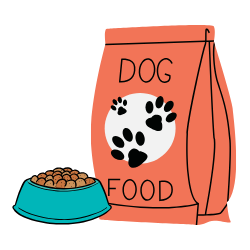Choosing the right dry food for your dog can feel like solving a gourmet puzzle—except your customer is a tail-wagging critic with a passion for floor snacks. With countless options on the shelves, how do you know which kibble will keep your pup’s belly full and tail wagging? Let’s break it down.
1. Read the Ingredient List Like a Pro
If the first ingredient is something vague like “meat by-product,” put that bag down and back away slowly. Look for high-quality proteins like chicken, beef, or salmon at the top of the list. Bonus points if the ingredients sound like something you’d eat (though we don’t recommend taste-testing).
2. Consider Your Dog’s Age, Size, and Lifestyle
A sprightly puppy, a couch-potato senior, and a marathon-running border collie all have different nutritional needs. Look for formulas labeled for their life stage—puppy, adult, or senior—and consider breed-specific formulas for extra-tailored nutrition.
3. Avoid the Junk
Just like humans don’t thrive on a diet of potato chips and soda, your pup doesn’t need artificial flavors, colors, or excessive fillers like corn, wheat, or soy. These can cause allergies and digestive issues—unless your dog has a stomach of steel (looking at you, Labrador Retrievers).
4. Check for AAFCO Approval
The Association of American Feed Control Officials (AAFCO) sets nutritional standards for pet food. If the bag doesn’t have an AAFCO statement, you might as well be feeding your dog cardboard. Look for phrases like “complete and balanced” to ensure they’re getting all the good stuff.
5. Do the Taste Test (With Your Dog, Not You)
Even the most nutritious food is useless if your dog refuses to eat it. Try a small bag first and see if your pup wolfs it down or gives you the “are you serious?” side-eye.
6. Consider Special Dietary Needs
Does your dog have a sensitive stomach? Grain allergies? A tendency to put on a few extra pounds? There are grain-free, limited-ingredient, and weight-management formulas designed to meet their needs—because nobody likes an upset tummy or extra vet visits.
7. Price vs. Quality: Finding the Sweet Spot
You don’t have to take out a second mortgage to feed your dog well, but remember—cheaper isn’t always better. Higher-quality food often means better health, fewer vet bills, and less ahem mess to clean up in the yard.
Final Thoughts: Because Your Dog Deserves the Best
Picking the right dry food for your dog doesn’t have to be ruff. With a little research, a dash of trial and error, and a lot of tail wags, you’ll find the perfect kibble that keeps your furry best friend happy and healthy. Now go forth and conquer the pet food aisle like the responsible dog parent you are!


Leave a Reply